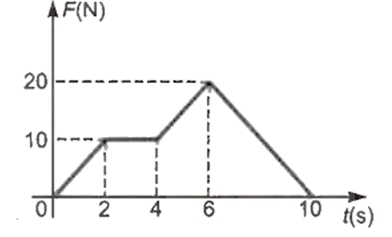 Multiple Choice Questions
Multiple Choice QuestionsA stationary body of mass 3 kg explodes into three equal pieces. Two of the pieces fly off in two mutually perpendicular directions, one with a velocity of ms-1 and the other with a velocity of ms-1. If the explosion occurs in 10-4 s, the average force acting on the third piece in newton is
A mass of 1 kg is just able to slide down the slope of an inclined rough surface when the angle of inclination is 60°. The minimum force necessary to pull the mass up the inclined plane (g = 10 ms-2) is
14.14 N
17.32 N
10 N
16.66 N
A block of mass m is resting on a smooth horizontal surface. One end of a uniform rope of mass is fixed to the block, which is pulled in the horizontal direction by applying force F at the other end. The tension in the middle of the rope is
A bullet of mass 0.05 kg moving with a speed of 80 ms enters a wooden block and is stopped after a distance of 0.40 m. The average resistive force exerted by the block on the below is
300 N
20 N
400 N
40 N
A particle of mass 2 kg is initially at rest. A force acts on it whose magnitude changes with time. The force time graph is shown below.

The velocity of the particle after 10 s is
20 ms-1
10 ms-1
50 ms-1
26 ms-1
C.
50 ms-1
Area under the F-t curve = change in momentum
The sum of the magnitudes of two forces acting at a point is 18 N and the magnitude of their resultant is 12 N. If the resultant is at 90° with the smaller force, the magnitude of the forces in N are
6, 12
11, 7
5, 13
14, 4
A mass of 6 kg is suspended by a rope of length 2 m from a ceiling. A force of 50 N in the horizontal direction is applied at the mid-point of the rope. The angle made by the rope with the vertical, in equilibrium is
50°
60°
30°
40°
A shell at rest at the origin explodes into three fragments of masses 1 kg, 2 kg and m kg. The 1 kg and 2 kg pieces fly off with speeds of 5 ms-1 along x-axis and 6 ms-2 along y-axis respectively. If the m kg piece flies off with a speed of 6.5 ms-1, the total mass of the shell must be
4 kg
5 kg
3.5 kg
4.5 kg
If the road is unbanked and the coefficient of friction between the road and the tyres is 0.8, then the maximum speed with which an automobile can move around a curve of 84.5 m radius without slipping (g = 10 ms-2) is
26 ms-1
67.6 ms-1
13 ms-1
36.7 ms-1
Three blocks of masses m1 m2 and m3 are connected by massless string as shown kept on a frictionless table.

They are pulled with a force T3 = 40 N. If m1 = 10 kg, m2 = 6 kg and m3 = 4 kg, the tension T2 will be
20 N
40 N
10 N
32 N
